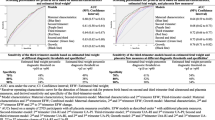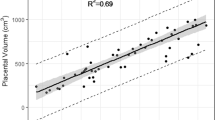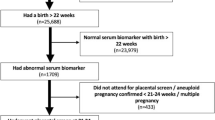Abstract
Preterm birth (PTB) (<37 weeks’ gestational age (GA)) is associated with increased risk of short- and long-term sequelae. Accurate predictive tools allow to improve the outcomes of those born preterm by offering early obstetric interventions to mothers at high-risk of PTB.
Methods: This study combines a wide range of structural and functional MRI parameters, from the fetal head, lung, placenta with clinically available Ultrasound and outcome data. A preprocessing pipeline adapted to the special requirements of the often incomplete and highly GA dependant data and a supervised machine learning model based on these derived markers derived is proposed. Data from 58 preterm and 217 term-born neonates were analysed.
Results: The best SVR model achieved an \(\text {R}^{2}\) value of 0.67 and correctly predicted 92% of true preterm cases using a combination of two maternal and four fetal features.
Conclusion: The significance of this study is uncovering the potential of markers derived from multi-modal imaging data in the prediction of PTB using large-scale fetal studies. This study paves the way for future studies focusing on at-risk women to further enhance the data set and thus predictive power.
Lisa Story and Jana Hutter are joint senior authors.
Access this chapter
Tax calculation will be finalised at checkout
Purchases are for personal use only
Similar content being viewed by others
References
DeVore, G.: Computing the Z score and centiles for cross-sectional analysis: a practical approach. J. Ultrasound Med. 36, 459–473 (2017)
McIntosh, J., Feltovich, H., Berghella, V., Manuck, T., Society for Maternal-Fetal Medicine (SMFM): The role of routine cervical length screening in selected high- and low-risk women for preterm birth prevention. Am. J. Obstet. Gynecol. 215, B2–B7 (2016)
Hughes, E.J., Price, A.N., McCabe, L., et al.: The effect of maternal position on venous return for pregnant women during MRI. NMR Biomed. 34, e4475 (2021)
Story, L., et al.: Brain volumetry in fetuses that deliver very preterm. NeuroImage Clin. 30, 102650 (2021)
Story, L., et al.: Foetal lung volumes in pregnant women who deliver very pretermy. Pediatr. Res. 87, 1066–1071 (2020a)
Uus, A., et al.: Deformable slice-to-volume registration for reconstruction of quantitative T2* placental and fetal MRI. In: Hu, Y., et al. (eds.) ASMUS/PIPPI -2020. LNCS, vol. 12437, pp. 222–232. Springer, Cham (2020). https://doi.org/10.1007/978-3-030-60334-2_22
Story, L., Zhang, T., Uus, A., et al.: Antenatal thymus volumes in fetuses that delivered \(<\)32 weeks’ gestation: an MRI pilot study. Acta Obstet. Gynecol. Scand. 100, 1040–1050 (2020b). https://doi.org/10.1111/aogs.13983
Suff, N., Story, L., Shennan, A.: The prediction of preterm delivery: what is new? Semin. Fetal Neonatal Med. 24(1), 27–32 (2019)
Luu, T.M., Rehman Mian, M.O., Nuyt, A.M.: Long-term impact of preterm birth: neurodevelopmental and physical health outcomes. Clin. Perinatol. 44(2), 305–314 (2017). Delivery in the Periviable Period
You, J., Ma, X., Yi, D., Ding, Y., Kochenderfer, M., Leskovec, J.: Handling missing data with graph representation learning. In: NeurpIPS 2020 Proceedings (2020)
Slator, P.J., et al.: Data-driven multi-contrast spectral microstructure imaging with InSpect. Med. Image Anal. 71, 102045 (2021)
Sørensen, A., Hutter, J., Seed, M., Grant, P.E., Gowland, P.: T2*-weighted placental MRI: basic research tool or emerging clinical test for placental dysfunction? Ultrasound Obstet. Gynecol. 55, 293–302 (2020)
Ho, A.E.P., et al.: T2* placental magnetic resonance imaging in preterm preeclampsia an observational cohort study. Hypertension 75, 1523–1531 (2020)
Watson, H., et al.: Development and validation of predictive models for QUiPP App vol 2: tool for predicting preterm birth in asymptomatic high?risk women. USOG 55, 348–356 (2019b)
WHO: Preterm birth (2018). https://www.who.int/en/news-room/fact-sheets/detail/preterm-birth. Accessed 24 Jan 2021
WHO: The top 10 causes of death (2020). https://www.who.int/news-room/fact-sheets/detail/the-top-10-causes-of-death. Accessed 28 Mar 2021
Author information
Authors and Affiliations
Corresponding author
Editor information
Editors and Affiliations
Rights and permissions
Copyright information
© 2021 Springer Nature Switzerland AG
About this paper
Cite this paper
Heinsalu, R. et al. (2021). Predicting Preterm Birth Using Multimodal Fetal Imaging. In: Sudre, C.H., et al. Uncertainty for Safe Utilization of Machine Learning in Medical Imaging, and Perinatal Imaging, Placental and Preterm Image Analysis. UNSURE PIPPI 2021 2021. Lecture Notes in Computer Science(), vol 12959. Springer, Cham. https://doi.org/10.1007/978-3-030-87735-4_27
Download citation
DOI: https://doi.org/10.1007/978-3-030-87735-4_27
Published:
Publisher Name: Springer, Cham
Print ISBN: 978-3-030-87734-7
Online ISBN: 978-3-030-87735-4
eBook Packages: Computer ScienceComputer Science (R0)





